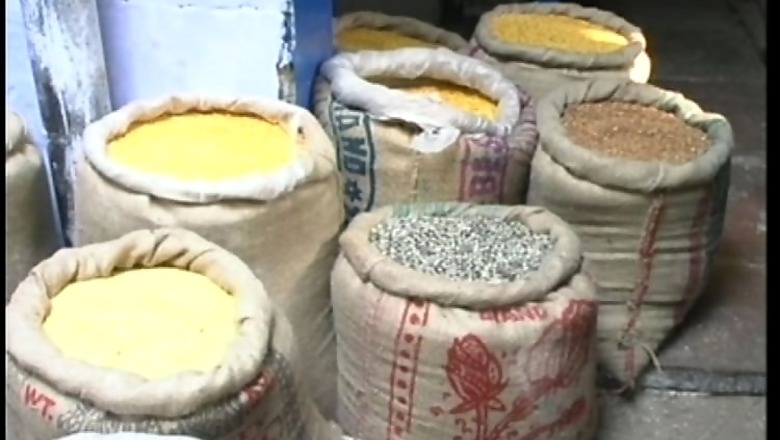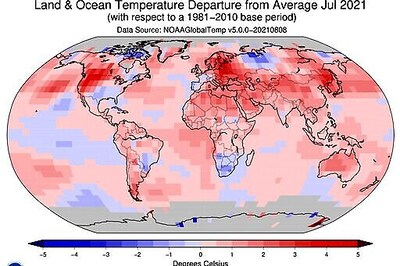
views
No other people consume as many varieties of dal as Indians do and no Indian meal is complete a dal accompaniment. Their high prices make homemakers anxious and governments nervous. Pigeonpea has touched levels never seen before. Over the past ten years, wholesale prices of pulses have more than doubled or tripled, that of moongbean rising the most followed by blackgram, lentil, chickpea and pigeonpea. The averages conceal stark volatility. Retail prices are stinging.
Production of pulses has risen handsomely in recent years. In 2013-14, it reached a high of 19 million tonnes, about nine million tonnes more in 2000-2001. Through production has increased by three-fourths since then, it has been unable to keep pace with demand. Availability per person has declined to 42 grams per day.
Narendra Pratap Singh, Director, Indian Institute of Pulses Research, Kanpur, said, “Our domestic production is less than what we consume in our domestic market. While cereals have picked up and productivity increased pulses have not shown the same pace in productivity increase. That is why production is less than current requirement.”
The quantity imported has more than doubled over the past ten years. It has gone past three million tonne mark. This is 16 percent of domestic production. Pulses are the second largest item of food imports after cooking oils, and account for ten percent of the country’s total agricultural import bill. Because of high Indian demand, import prices have also more than doubled during this period.
CL Lakshmipathi Gowda, Former Dy D-G, Icrisat, Hyderabad, said, “All I can say is we all need to work together, be it the agricultural extension department, or the department of agriculture itself, the state agriculture universities and even the ICAR and the National Food Security Mission. All of them need to work together. There are all these efforts going on but they are un-coordinated and haphazard. If only we can put all these things together, we can definitely do wonders. The money is being spent but it is not being spent in a coordinated manner and efforts are disjointed and that is why we are not seeing the final result that should come.
India is the largest producer of pulses in the world with a quarter of the global share. It has a pole position in certain crops. In chickpea or chana, which is the most consumed pulse in the country, India’s share is 67 percent. In pigeonpea, which is the second most consumed, it is 64 percent. The annual growth rate of pulses worldwide lagged that of rice and wheat for forty years till 2001. There has been a reversal since then. Area under pulses in India has remained flat at around 25 million hectares for the past twenty five years. The increase in production has been due to a modest rise in yield. Erratic weather has been a factor in discouraging farmers.
“People have given up on cultivating pulses because they are fed up. Earlier those who used to sow one or two hectares now do a part of it for their own consumption,” said Anil Sharma, Farmer, Kanpur Dehat.
Farmers like Udai Bir Singh of Kanpur do not have the confidence to grow traditional long-duration pigeonpea. Singh is well-versed with the agronomy of the crop; he has picked up quite a lot from scientists at Kanpur’s pulses research institute. Pigeonpea is low-cost and low maintenance requiring just one or two irrigations, Yet, Singh has decided that a crop of nine months is just too much exposure to risky weather.
But pigeopea prices have been tempting enough for some farmers to place hope above experience. The met department’s prediction of scanty rainfall this season has encouraged them to plant it, as pigeonpea thrives with a little moisture in dry weather.
Shiv Pratap Singh, Village Mauhar, Kanpur Dehat, said, “I have done arhar because in this land I am able to take out minimum production. We are so trained in chana and moong and arhar that we can manage. Arhar has three flushes, so even if we do not get a harvest the first time or the second, we manage to take out production by using pesticides or with advice of scientist SK Singh of IIPR. We are a little knowledgeable about pulses because we have been doing it since 2006.”
Preparations for sowing were in full swing in the Gulbarga area as well. The local research institute had exhausted its stock of seed, and would have borne the brunt of farmers’ anger, if delayed rains had not curbed their enthusiasm for the crop in parts of the district. The temperamental weather had been quite generous in other parts, enabling Vital Chavan to sow all sixteen acres with a variety of pulses. The crop was a foot high when we visited him.
Through farmers are allured by the promissory note of handsome gains, they are seldom able to encash it. Small holders usually borrow on the security of their produce which they are compelled to sell as soon as they harvest, when prices are at their lowest. A boom-bust cycle prevails which explains price volatility. Even the government open market purchases to stabilize prices do not help smallholders.
Sharad Tenglikar, Professor of Community Medicine and Farmer, Gulbarga, said, “The farmers are with the commission agents in the grip of the commission agents. They take money the whole year from them and these commission agents never allow them to go to the govt procurement cell. And even if they go to the govt procurement cell there are three or four documents to be brought and these documents it becomes difficult for them to bring it at that stage. They want money so earlier. I think the policy makers should see to it that somehow the farmers get benefitted.”
Often the policies of the government aggravate the plight of small holders. Since it does not procure pulses minimum support prices do not mean much. States like Madhya Pradesh give an additional bonus for wheat procured, which shifts land away from competing chickpea or chana. Imports, to relieve shortage, have persisted long after their expiry date, causing prices to collapse. Even the subsidy scheme works against pulses, because the prices of potassium and phosphate, which they need are market-based while those of urea or nitrogen, which they do not need, are subsidized.
Sushil K Chaturvedi, Head Crop Improvement, Indian Institute of Pulses Research, said, “The pulses growers must be given some incentive may be per unit area because they fix 50-60 kg of nitrogen per acre. If we account the improvement in soil fertility, soil texture, sustainable production of rice and wheat for which we need pulses production, if those benefits are accounted for, the minimum support prices of pulses should be good and government should encourage farmers either with msp or incentive per unit area.”
Storage is also an issue that works against small farmers. Processed dals keep well but insects known as bruchids tends to get attracted to whole pulses. This is major worry with monsoon crops which cannot be easily dried. Just as the government has incentivised cold storages for potatoes, it needs to craft a policy to encourage the creation of godowns for pulses.
There has been impressive growth in the area, production and productivity of chickpea or chana. Production in 2013-14 was the highest ever, and area came close to the peak of 1959-60. This is a crop that is not sensitive to heat or light; hence the loss of four million hectares in cool north India has been made up in warm central and southern India. The development of short duration varieties that can tolerate drought and heat has helped. There is a need to create varieties that combine both the traits. Large seeded kabuli chana has been developed and small quantities are being exported. A machine harvestable variety should persuade those who are deterred by the high labor cost of harvesting.
SM Mannur, Principal Scientists, Agriculture Research Station, Gulbaga, said, “Harvesting was tedious. Now we have in this research station we have developed one variety That is GBM 2, which is sufficiently tall about two feet height and upper part of one feet is productive and below that is the non-productive part. There we can go for mechanized harvesting. Lot of farmers can save two things. Loss due to harvest about 20 percent will be saved as well as labour cost of around 20 percent, around 40 percent can be saved.”
Pigeonpea is the second most consumed dal in India. Productivity has stagnated at around 700 kg per hectare for many decades because farmers in northwest India are shunning the high-yielding but long duration nine-month variety. Short duration ones are not very productive. Hyderabad’s Icrisat has now developed a hybrid; the first for a pulse crop but seed multiplication is an issue. Hybrid pigeonpea yields 2,500 to 3,000 kg per hectare. Opinion is divided on whether these yields can be achieved in farmers’ fields, but Icrisat contests the scepticism.
C L Lakshmipathi Gowda said, “These hybrids have been tested under varied conditions in shallow black soils, medium black soils, and even deep black soils and the advantage of hybrids over varieties has been reasonably consistent. In very dry areas we may get slightly lower advantage say 30 percent but if the soils are better we may get 45 to 50 percent more. But one of the best things we found in hybrids is its drought tolerance. Because they grow fast they put root system very deep and they can get water from the lower levels so they are more drought tolerant than normal varieties.”
Moongbean is an easily digestible pulse of which over a million tonnes is produced in about three million hectares. The development of short duration varieties maturing in about sixty days has made it an opportunistic crop that can fit into the rice-rice cycle of eastern India or the rice-wheat pattern of central and north-west India.
“We are advising farmers in Punjab, Haryana and Western UP, seat of green revolution, productivity of wheat and rice is very high, we say at least one crop you grow a legume for sustainability. And in recent years lot of area has come in moong bean. Summer rice has stopped. Moong bean has come in a big way. IN last four five years, area in summer has come under moong bean,” said Narendra Pratap Singh.
Production of pigeonpea and chickpea can increase by forty percent according to some estimates if losses caused by a pest called the pod borer are eliminated. Genetically-modified Bt technology employed against the bollworm with good results in cotton can be used in chickpea and pigeonpea as well and research institutes in India are engaged in it.
C L Lakshmipathi Gowda said, “the major problem still remains is the pod borer, which is a major problem and that is where we do not have good available resistance in the local varieties so we have to depend on genetic modification. This is where Bt chick pea or Bt pigeon pea are going to be of help but scientists are constrained because we cannot go field level trials because there is a moratorium on this but if that can happen, that will be the biggest rev oltuion that can happen in both chick pea and pigeon pea if we can get both Bt chick pea and Bt pigeon pea which can reduce the damage by pod borers.”
The production of seeds needs greater attention from the public sector. Private companies are little interested in the production of seeds for pulses crops as farmers can reproduce them on their own. The seed replacement ratio varies with states and crops. In Andhra it is as high as 70 percent for chick pea; the ideal is about 25 percent. The Indian Institute of Pulses Research claims it has played it part by producing enough breeder seeds. The hitch is in multiplying them in enough quantities to meets farmers’ demand.
“The breeder seed production has been very good. We have achieved 15,000 quintals of breeder seeds. And that is sufficient for pulses production in India. For 24 million ha it is sufficient. But the subsequent conversin into foundation seed and certified seed, the commercial seed which goes to farmers, the conversion is not happening. If there is proper conversion then farmers can get quality seeds,” said Sushil Kumar Chaturvedi.
Seeds fetch a higher price than unprocessed dals but require producers to be diligent Seed companies engage groups of farmers but if quality parameters are not met, the lot is rejected and the entire group suffers.
Anil Mishra said, “It does not require more effort but you have to follow a method. When the seed goes there (to the testing laboratory) it fails. We waste on transportation and we sell it as pulses. That is why farmers are dropping out of seed production.”
To know more, watch 'Smart Agriculture' presented by Monsanto, every Saturday & Sunday at 4:30 PM and Monday at 5:30 PM on CNN-IBN and every Saturday & Sunday at 4:30 PM on CNBC-Awaaz.



















Comments
0 comment